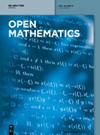求助PDF
{"title":"有界域中具有 p-拉普拉奇的薛定谔-泊松系统的纤维化方法","authors":"Jinfeng Xue, Libo Wang","doi":"10.1515/math-2024-0015","DOIUrl":null,"url":null,"abstract":"In this article, we study a <jats:italic>p</jats:italic>-Laplacian Schrödinger-Poisson system involving a parameter <jats:inline-formula> <jats:alternatives> <jats:inline-graphic xmlns:xlink=\"http://www.w3.org/1999/xlink\" xlink:href=\"graphic/j_math-2024-0015_eq_001.png\"/> <m:math xmlns:m=\"http://www.w3.org/1998/Math/MathML\"> <m:mi>q</m:mi> <m:mo>≠</m:mo> <m:mn>0</m:mn> </m:math> <jats:tex-math>q\\ne 0</jats:tex-math> </jats:alternatives> </jats:inline-formula> in bounded domains. By using the Nehari manifold and the fibering method, we obtain the non-existence and multiplicity of nontrivial solutions. On one hand, there exists <jats:inline-formula> <jats:alternatives> <jats:inline-graphic xmlns:xlink=\"http://www.w3.org/1999/xlink\" xlink:href=\"graphic/j_math-2024-0015_eq_002.png\"/> <m:math xmlns:m=\"http://www.w3.org/1998/Math/MathML\"> <m:msup> <m:mrow> <m:mi>q</m:mi> </m:mrow> <m:mrow> <m:mo>*</m:mo> </m:mrow> </m:msup> <m:mo>></m:mo> <m:mn>0</m:mn> </m:math> <jats:tex-math>{q}^{* }\\gt 0</jats:tex-math> </jats:alternatives> </jats:inline-formula> such that only the trivial solution is admitted for <jats:inline-formula> <jats:alternatives> <jats:inline-graphic xmlns:xlink=\"http://www.w3.org/1999/xlink\" xlink:href=\"graphic/j_math-2024-0015_eq_003.png\"/> <m:math xmlns:m=\"http://www.w3.org/1998/Math/MathML\"> <m:mi>q</m:mi> <m:mo>∈</m:mo> <m:mrow> <m:mo>(</m:mo> <m:mrow> <m:msup> <m:mrow> <m:mi>q</m:mi> </m:mrow> <m:mrow> <m:mo>*</m:mo> </m:mrow> </m:msup> <m:mo>,</m:mo> <m:mo>+</m:mo> <m:mi>∞</m:mi> </m:mrow> <m:mo>)</m:mo> </m:mrow> <m:mo>.</m:mo> </m:math> <jats:tex-math>q\\in \\left({q}^{* },+\\infty ).</jats:tex-math> </jats:alternatives> </jats:inline-formula> On the other hand, there are two positive solutions existing for <jats:inline-formula> <jats:alternatives> <jats:inline-graphic xmlns:xlink=\"http://www.w3.org/1999/xlink\" xlink:href=\"graphic/j_math-2024-0015_eq_004.png\"/> <m:math xmlns:m=\"http://www.w3.org/1998/Math/MathML\"> <m:mi>q</m:mi> <m:mo>∈</m:mo> <m:mrow> <m:mo>(</m:mo> <m:mrow> <m:mn>0</m:mn> <m:mo>,</m:mo> <m:msubsup> <m:mrow> <m:mi>q</m:mi> </m:mrow> <m:mrow> <m:mn>0</m:mn> </m:mrow> <m:mrow> <m:mo>*</m:mo> </m:mrow> </m:msubsup> <m:mo>+</m:mo> <m:mi>ε</m:mi> </m:mrow> <m:mo>)</m:mo> </m:mrow> </m:math> <jats:tex-math>q\\in \\left(0,{q}_{0}^{* }+\\varepsilon )</jats:tex-math> </jats:alternatives> </jats:inline-formula>, where <jats:inline-formula> <jats:alternatives> <jats:inline-graphic xmlns:xlink=\"http://www.w3.org/1999/xlink\" xlink:href=\"graphic/j_math-2024-0015_eq_005.png\"/> <m:math xmlns:m=\"http://www.w3.org/1998/Math/MathML\"> <m:mi>ε</m:mi> <m:mo>></m:mo> <m:mn>0</m:mn> </m:math> <jats:tex-math>\\varepsilon \\gt 0</jats:tex-math> </jats:alternatives> </jats:inline-formula> and <jats:inline-formula> <jats:alternatives> <jats:inline-graphic xmlns:xlink=\"http://www.w3.org/1999/xlink\" xlink:href=\"graphic/j_math-2024-0015_eq_006.png\"/> <m:math xmlns:m=\"http://www.w3.org/1998/Math/MathML\"> <m:msubsup> <m:mrow> <m:mi>q</m:mi> </m:mrow> <m:mrow> <m:mn>0</m:mn> </m:mrow> <m:mrow> <m:mo>*</m:mo> </m:mrow> </m:msubsup> <m:mo>+</m:mo> <m:mi>ε</m:mi> <m:mo><</m:mo> <m:msup> <m:mrow> <m:mi>q</m:mi> </m:mrow> <m:mrow> <m:mo>*</m:mo> </m:mrow> </m:msup> <m:mo>.</m:mo> </m:math> <jats:tex-math>{q}_{0}^{* }+\\varepsilon \\lt {q}^{* }.</jats:tex-math> </jats:alternatives> </jats:inline-formula> In particular, <jats:inline-formula> <jats:alternatives> <jats:inline-graphic xmlns:xlink=\"http://www.w3.org/1999/xlink\" xlink:href=\"graphic/j_math-2024-0015_eq_007.png\"/> <m:math xmlns:m=\"http://www.w3.org/1998/Math/MathML\"> <m:msup> <m:mrow> <m:mi>q</m:mi> </m:mrow> <m:mrow> <m:mo>*</m:mo> </m:mrow> </m:msup> </m:math> <jats:tex-math>{q}^{* }</jats:tex-math> </jats:alternatives> </jats:inline-formula> and <jats:inline-formula> <jats:alternatives> <jats:inline-graphic xmlns:xlink=\"http://www.w3.org/1999/xlink\" xlink:href=\"graphic/j_math-2024-0015_eq_008.png\"/> <m:math xmlns:m=\"http://www.w3.org/1998/Math/MathML\"> <m:msubsup> <m:mrow> <m:mi>q</m:mi> </m:mrow> <m:mrow> <m:mn>0</m:mn> </m:mrow> <m:mrow> <m:mo>*</m:mo> </m:mrow> </m:msubsup> </m:math> <jats:tex-math>{q}_{0}^{* }</jats:tex-math> </jats:alternatives> </jats:inline-formula> correspond to the supremum for the nonlinear generalized Rayleigh quotients, respectively. The specific form of the nonlinear generalized Rayleigh quotients is calculated. Moreover, it is worth mentioning that we also obtain the qualitative properties associated with the energy level of the solutions.","PeriodicalId":48713,"journal":{"name":"Open Mathematics","volume":"42 1","pages":""},"PeriodicalIF":0.9000,"publicationDate":"2024-06-20","publicationTypes":"Journal Article","fieldsOfStudy":null,"isOpenAccess":false,"openAccessPdf":"","citationCount":"0","resultStr":"{\"title\":\"The fibering method approach for a Schrödinger-Poisson system with p-Laplacian in bounded domains\",\"authors\":\"Jinfeng Xue, Libo Wang\",\"doi\":\"10.1515/math-2024-0015\",\"DOIUrl\":null,\"url\":null,\"abstract\":\"In this article, we study a <jats:italic>p</jats:italic>-Laplacian Schrödinger-Poisson system involving a parameter <jats:inline-formula> <jats:alternatives> <jats:inline-graphic xmlns:xlink=\\\"http://www.w3.org/1999/xlink\\\" xlink:href=\\\"graphic/j_math-2024-0015_eq_001.png\\\"/> <m:math xmlns:m=\\\"http://www.w3.org/1998/Math/MathML\\\"> <m:mi>q</m:mi> <m:mo>≠</m:mo> <m:mn>0</m:mn> </m:math> <jats:tex-math>q\\\\ne 0</jats:tex-math> </jats:alternatives> </jats:inline-formula> in bounded domains. By using the Nehari manifold and the fibering method, we obtain the non-existence and multiplicity of nontrivial solutions. On one hand, there exists <jats:inline-formula> <jats:alternatives> <jats:inline-graphic xmlns:xlink=\\\"http://www.w3.org/1999/xlink\\\" xlink:href=\\\"graphic/j_math-2024-0015_eq_002.png\\\"/> <m:math xmlns:m=\\\"http://www.w3.org/1998/Math/MathML\\\"> <m:msup> <m:mrow> <m:mi>q</m:mi> </m:mrow> <m:mrow> <m:mo>*</m:mo> </m:mrow> </m:msup> <m:mo>></m:mo> <m:mn>0</m:mn> </m:math> <jats:tex-math>{q}^{* }\\\\gt 0</jats:tex-math> </jats:alternatives> </jats:inline-formula> such that only the trivial solution is admitted for <jats:inline-formula> <jats:alternatives> <jats:inline-graphic xmlns:xlink=\\\"http://www.w3.org/1999/xlink\\\" xlink:href=\\\"graphic/j_math-2024-0015_eq_003.png\\\"/> <m:math xmlns:m=\\\"http://www.w3.org/1998/Math/MathML\\\"> <m:mi>q</m:mi> <m:mo>∈</m:mo> <m:mrow> <m:mo>(</m:mo> <m:mrow> <m:msup> <m:mrow> <m:mi>q</m:mi> </m:mrow> <m:mrow> <m:mo>*</m:mo> </m:mrow> </m:msup> <m:mo>,</m:mo> <m:mo>+</m:mo> <m:mi>∞</m:mi> </m:mrow> <m:mo>)</m:mo> </m:mrow> <m:mo>.</m:mo> </m:math> <jats:tex-math>q\\\\in \\\\left({q}^{* },+\\\\infty ).</jats:tex-math> </jats:alternatives> </jats:inline-formula> On the other hand, there are two positive solutions existing for <jats:inline-formula> <jats:alternatives> <jats:inline-graphic xmlns:xlink=\\\"http://www.w3.org/1999/xlink\\\" xlink:href=\\\"graphic/j_math-2024-0015_eq_004.png\\\"/> <m:math xmlns:m=\\\"http://www.w3.org/1998/Math/MathML\\\"> <m:mi>q</m:mi> <m:mo>∈</m:mo> <m:mrow> <m:mo>(</m:mo> <m:mrow> <m:mn>0</m:mn> <m:mo>,</m:mo> <m:msubsup> <m:mrow> <m:mi>q</m:mi> </m:mrow> <m:mrow> <m:mn>0</m:mn> </m:mrow> <m:mrow> <m:mo>*</m:mo> </m:mrow> </m:msubsup> <m:mo>+</m:mo> <m:mi>ε</m:mi> </m:mrow> <m:mo>)</m:mo> </m:mrow> </m:math> <jats:tex-math>q\\\\in \\\\left(0,{q}_{0}^{* }+\\\\varepsilon )</jats:tex-math> </jats:alternatives> </jats:inline-formula>, where <jats:inline-formula> <jats:alternatives> <jats:inline-graphic xmlns:xlink=\\\"http://www.w3.org/1999/xlink\\\" xlink:href=\\\"graphic/j_math-2024-0015_eq_005.png\\\"/> <m:math xmlns:m=\\\"http://www.w3.org/1998/Math/MathML\\\"> <m:mi>ε</m:mi> <m:mo>></m:mo> <m:mn>0</m:mn> </m:math> <jats:tex-math>\\\\varepsilon \\\\gt 0</jats:tex-math> </jats:alternatives> </jats:inline-formula> and <jats:inline-formula> <jats:alternatives> <jats:inline-graphic xmlns:xlink=\\\"http://www.w3.org/1999/xlink\\\" xlink:href=\\\"graphic/j_math-2024-0015_eq_006.png\\\"/> <m:math xmlns:m=\\\"http://www.w3.org/1998/Math/MathML\\\"> <m:msubsup> <m:mrow> <m:mi>q</m:mi> </m:mrow> <m:mrow> <m:mn>0</m:mn> </m:mrow> <m:mrow> <m:mo>*</m:mo> </m:mrow> </m:msubsup> <m:mo>+</m:mo> <m:mi>ε</m:mi> <m:mo><</m:mo> <m:msup> <m:mrow> <m:mi>q</m:mi> </m:mrow> <m:mrow> <m:mo>*</m:mo> </m:mrow> </m:msup> <m:mo>.</m:mo> </m:math> <jats:tex-math>{q}_{0}^{* }+\\\\varepsilon \\\\lt {q}^{* }.</jats:tex-math> </jats:alternatives> </jats:inline-formula> In particular, <jats:inline-formula> <jats:alternatives> <jats:inline-graphic xmlns:xlink=\\\"http://www.w3.org/1999/xlink\\\" xlink:href=\\\"graphic/j_math-2024-0015_eq_007.png\\\"/> <m:math xmlns:m=\\\"http://www.w3.org/1998/Math/MathML\\\"> <m:msup> <m:mrow> <m:mi>q</m:mi> </m:mrow> <m:mrow> <m:mo>*</m:mo> </m:mrow> </m:msup> </m:math> <jats:tex-math>{q}^{* }</jats:tex-math> </jats:alternatives> </jats:inline-formula> and <jats:inline-formula> <jats:alternatives> <jats:inline-graphic xmlns:xlink=\\\"http://www.w3.org/1999/xlink\\\" xlink:href=\\\"graphic/j_math-2024-0015_eq_008.png\\\"/> <m:math xmlns:m=\\\"http://www.w3.org/1998/Math/MathML\\\"> <m:msubsup> <m:mrow> <m:mi>q</m:mi> </m:mrow> <m:mrow> <m:mn>0</m:mn> </m:mrow> <m:mrow> <m:mo>*</m:mo> </m:mrow> </m:msubsup> </m:math> <jats:tex-math>{q}_{0}^{* }</jats:tex-math> </jats:alternatives> </jats:inline-formula> correspond to the supremum for the nonlinear generalized Rayleigh quotients, respectively. The specific form of the nonlinear generalized Rayleigh quotients is calculated. Moreover, it is worth mentioning that we also obtain the qualitative properties associated with the energy level of the solutions.\",\"PeriodicalId\":48713,\"journal\":{\"name\":\"Open Mathematics\",\"volume\":\"42 1\",\"pages\":\"\"},\"PeriodicalIF\":0.9000,\"publicationDate\":\"2024-06-20\",\"publicationTypes\":\"Journal Article\",\"fieldsOfStudy\":null,\"isOpenAccess\":false,\"openAccessPdf\":\"\",\"citationCount\":\"0\",\"resultStr\":null,\"platform\":\"Semanticscholar\",\"paperid\":null,\"PeriodicalName\":\"Open Mathematics\",\"FirstCategoryId\":\"100\",\"ListUrlMain\":\"https://doi.org/10.1515/math-2024-0015\",\"RegionNum\":4,\"RegionCategory\":\"数学\",\"ArticlePicture\":[],\"TitleCN\":null,\"AbstractTextCN\":null,\"PMCID\":null,\"EPubDate\":\"\",\"PubModel\":\"\",\"JCR\":\"Q1\",\"JCRName\":\"MATHEMATICS\",\"Score\":null,\"Total\":0}","platform":"Semanticscholar","paperid":null,"PeriodicalName":"Open Mathematics","FirstCategoryId":"100","ListUrlMain":"https://doi.org/10.1515/math-2024-0015","RegionNum":4,"RegionCategory":"数学","ArticlePicture":[],"TitleCN":null,"AbstractTextCN":null,"PMCID":null,"EPubDate":"","PubModel":"","JCR":"Q1","JCRName":"MATHEMATICS","Score":null,"Total":0}
引用次数: 0
引用
批量引用
The fibering method approach for a Schrödinger-Poisson system with p-Laplacian in bounded domains
In this article, we study a p -Laplacian Schrödinger-Poisson system involving a parameter q ≠ 0 q\ne 0 in bounded domains. By using the Nehari manifold and the fibering method, we obtain the non-existence and multiplicity of nontrivial solutions. On one hand, there exists q * > 0 {q}^{* }\gt 0 such that only the trivial solution is admitted for q ∈ ( q * , + ∞ ) . q\in \left({q}^{* },+\infty ). On the other hand, there are two positive solutions existing for q ∈ ( 0 , q 0 * + ε ) q\in \left(0,{q}_{0}^{* }+\varepsilon ) , where ε > 0 \varepsilon \gt 0 and q 0 * + ε < q * . {q}_{0}^{* }+\varepsilon \lt {q}^{* }. In particular, q * {q}^{* } and q 0 * {q}_{0}^{* } correspond to the supremum for the nonlinear generalized Rayleigh quotients, respectively. The specific form of the nonlinear generalized Rayleigh quotients is calculated. Moreover, it is worth mentioning that we also obtain the qualitative properties associated with the energy level of the solutions.

 求助内容:
求助内容: 应助结果提醒方式:
应助结果提醒方式:


